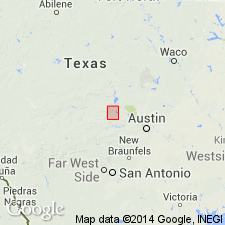
- Usage in publication:
-
- Valley Spring gneiss*
- Modifications:
-
- Overview
- AAPG geologic province:
-
- Llano uplift
Summary:
Is one to two divisions of the Llano series. This unit is the acidic unit that underlies the Packsaddle schist. Closely resembles granite where the granites are schistose. Contacts are irregular; they are sharp at some locations and interleaved at others. Difficult to separate from Packsaddle. The greatest distinction between the Packsaddle and the Valley Spring in that the former is dark and not massive, whereas the latter is light and massive. Valley Spring has bands of wollastonite, or metamorphosed limestone. Algonkian age. Geologic map. Mapped with the Packsaddle along the Llano River, Llano Co., TX on the Llano uplift.
Source: GNU records (USGS DDS-6; Denver GNULEX).

- Usage in publication:
-
- Valley Spring Gneiss
- AAPG geologic province:
-
- Llano uplift
Summary:
Pg. 3, 6-7, pl. 1. Valley Spring Gneiss of Llano Supergroup. Subdivided into (descending): (1) unit C, pink quartz-feldspar gneiss, pink leptite, and gray gneiss with pink feldspar augen near top (may correlate with Ragland's Lost Creek augen gneiss, see entry under Barnes and Schofield, 1964); (2) unit B, gray quartz-feldspar-biotite gneiss, and (3) unit A, pink quartz-feldspar gneiss (base not exposed in study area). Thickness 8,480 feet (2,555 m). Underlies, with gradational contact (100+ feet, 30+ m), the Honey Formation of Packsaddle Group of Llano Supergroup; contact placed at base of first hornblende schist of the Honey Formation. Interpreted to be of sedimentary origin. Age is Precambrian.
Confined to Cap Mountain quadrangle.
Source: Publication.
For more information, please contact Nancy Stamm, Geologic Names Committee Secretary.
Asterisk (*) indicates published by U.S. Geological Survey authors.
"No current usage" (†) implies that a name has been abandoned or has fallen into disuse. Former usage and, if known, replacement name given in parentheses ( ).
Slash (/) indicates name conflicts with nomenclatural guidelines (CSN, 1933; ACSN, 1961, 1970; NACSN, 1983, 2005, 2021). May be explained within brackets ([ ]).

